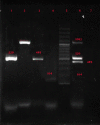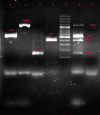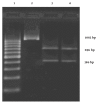Simultaneous and Rapid Detection of Salmonella typhi, Bacillus anthracis, and Yersinia pestis by Using Multiplex Polymerase Chain Reaction (PCR)
- PMID: 24719692
- PMCID: PMC3971784
- DOI: 10.5812/ircmj.9208
Simultaneous and Rapid Detection of Salmonella typhi, Bacillus anthracis, and Yersinia pestis by Using Multiplex Polymerase Chain Reaction (PCR)
Abstract
Background: Salmonella typhi, Bacillus anthracis, and Yersinia pestis are some serious human pathogens, which their early diagnosis is of great importance. Salmonella typhi, Bacillus anthracis, and Yersinia pestis cause typhoid fever, anthrax, and plague respectively. These bacteria can be used to make biologic weapons.
Objectives: In this study, we designed a new and rapid diagnostic method based on Uniplex and Multiplex PCR method.
Materials and methods: Uniplex and multiplex Polymerase Chain Reaction (PCR) were conducted on virulent genes of hp and invA of Salmonella typhimurium, Pa and chr of Bacillus anthracis, and pla of Yersinia pestis. A genome from other bacteria was used to study the specificity of the primer and the PCR test.
Results: Standard strains used in this study showed that primers were specific. As for sensitivity, it was shown that this method can diagnose 1-10 copies of the genome, or 1-10 Colony Forming Units (CFU) for each of the bacteria. All pieces except anthrax were sequenced in PCR to validate the product. DNA fragment resulted from Bacillus anthracis was confirmed by restriction enzyme digestions.
Conclusion: The designed methods are accurate, rapid, and inexpensive to find and differentiate these bacteria from similar bacteria. They can be applied for rapid diagnosis of these agents in different specimens, and bioterrorism cases.
Keywords: Bacillus anthracis; Multiplex PCR; Salmonella typhi; Yersinia pestis.
Figures




References
-
- Purver RonaldG. Chemical and biological terrorism: the threat according to the open literature. Canadian Security Intelligence Service; 1995.
-
- Okinaka R, Cloud K, Hampton O, Hoffmaster A, Hill K, Keim P, et al. Sequence, assembly and analysis of pX01 and pX02. J Appl Microbiol. 1999;87(2):261–2. - PubMed
-
- Franz DR, Jahrling PB, Friedlander AM, McClain DJ, Hoover DL, Bryne WR, et al. Clinical recognition and management of patients exposed to biological warfare agents. JAMA. 1997;278(5):399–411. - PubMed
-
- Inglesby TV, Dennis DT, Henderson DA, Bartlett JG, Ascher MS, Eitzen E, et al. Plague as a biological weapon: medical and public health management. Working Group on Civilian Biodefense. JAMA. 2000;283(17):2281–90. - PubMed
LinkOut - more resources
Full Text Sources
Other Literature Sources
Research Materials
Miscellaneous
